-
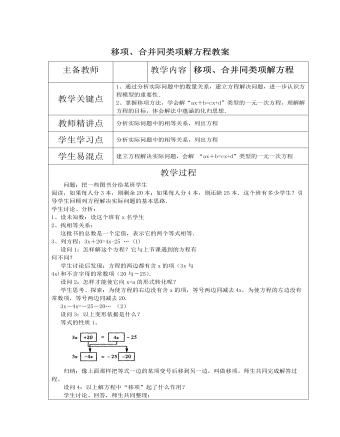
北师大初中七年级数学上册利用移项与合并同类项解一元一次方程教案2
练习:现在你能解答课本85页的习题3.1第6题吗?有一个班的同学去划船,他们算了一下,如果增加一条船,正好每条船坐6人,如果送还了一条船 ,正好每条船坐9人,问这个班共多少同学?小结提问:1、今天你又学会了解方程的哪些方法?有哪些步聚?每一步的依据是什么?2、现在你能回答前面提到的古老的代数书中的“对消”与“还原”是什么意思吗?3、今天讨论的问题中的相等关系又有何共同特点?学生思考后回答、整理:① 解方程的步骤及依据分别是:移项(等式的性质1)合并(分配律)系数化为1(等式的性质2)表示同一量的两个不同式子相等作业:1、 必做题:课本习题2、 选做题:将一块长、宽、高分别为4厘米、2厘米、3厘米的长方体橡皮泥捏成一个底面半径为2厘米的圆柱,它的高是多少?(精确到0.1厘米)

北师大版初中八年级数学上册二元一次方程(组)与一次函数说课稿
在第1环节基础上,再让同学认识到函数Y=2X-1的图象与方程2X-Y=1的对应关系,从而把两个方程组成方程组,让学生在理解二元一次方程与函数对应的基础上认识到方程组的解与交点坐标的对应关系,从而引出二元一次方程组的图象解法。3、例题训练,知识系统化通过书上的例1,用作图象的方法解方程组,让学生明白解题步骤与格式,从而规范理顺所学的图象法解方程组,例题由师生合作完成,由学生说老师写的方式。4、操作演练、形成技能让学生独立完成书P208随堂练习,给定时间,等多数学生完成后,实物投影其完成情况,并作出分析与评价。5、变式训练,延伸扩展通过让学生做收上P208的试一试,而后给一定时间相互交流,并请代表发言他的所悟,然而老师归纳总结,并让学生通过自已尝试与老师的点拔从“数”与“形”两个方面初步体会某些方程组的无解性,进一步发展学生数形结合的意识和能力。6、检测评价,课题作业
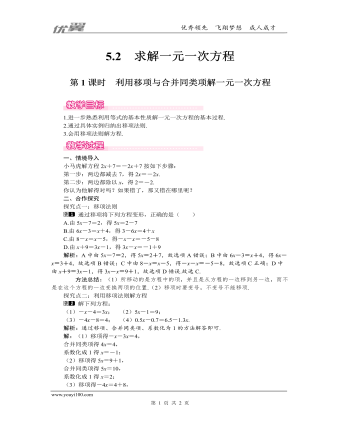
北师大初中七年级数学上册利用移项与合并同类项解一元一次方程教案1
(3)移项得-4x=4+8,合并同类项得-4x=12,系数化成1得x=-3;(4)移项得1.3x+0.5x=0.7+6.5,合并同类项得1.8x=7.2,系数化成1得x=4.方法总结:将所有含未知数的项移到方程的左边,常数项移到方程的右边,然后合并同类项,最后将未知数的系数化为1.特别注意移项要变号.探究点三:列一元一次方程解应用题把一批图书分给七年级某班的同学阅读,若每人分3本,则剩余20本,若每人分4本,则缺25本,这个班有多少学生?解析:根据实际书的数量可得相应的等量关系:3×学生数量+20=4×学生数量-25,把相关数值代入即可求解.解:设这个班有x个学生,根据题意得3x+20=4x-25,移项得3x-4x=-25-20,合并同类项得-x=-45,系数化成1得x=45.答:这个班有45人.方法总结:列方程解应用题时,应抓住题目中的“相等”、“谁比谁多多少”等表示数量关系的词语,以便从中找出合适的等量关系列方程.
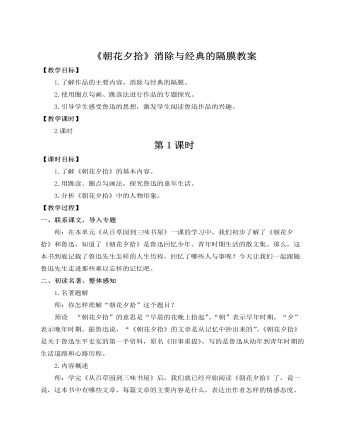
人教部编版七年级语文上册名著导读 《朝花夕拾》 消除与经典的隔膜教案
3.小组合作,交流阅读体会,填写阅读任务卡4.师点评并展示优秀的阅读任务卡【设计意图】本环节侧重寻找《朝花夕拾》中表现鲁迅先生儿童教育观念的地方,通过细节审视,深入体会鲁迅先生对于儿童教育观念的独特认识和深切关怀。在这轻松而有感染力的文字里,我们能真切地感受到鲁迅先生对儿童教育的切身感受。联系现实,让学生对鲁迅先生的儿童教育观的现实意义也有强烈的认同感,从而理解鲁迅先生,理解文本里的情感,拉近与文本的距离。三、汇报探究成果,评选优秀学生1.各小组内汇总专题探究阅读任务卡2.各小组内不记名投票,评选出最优秀的阅读任务卡3.师汇总各小组最优秀的阅读任务卡,在全班展示4.评选优秀汇报者针对最优秀的阅读任务卡和各小组汇报情况,全班填写“《朝花夕拾》阅读汇报评价表”,评选出三位阅读任务卡优秀制作者和一名优秀专题汇报者。课件出示:
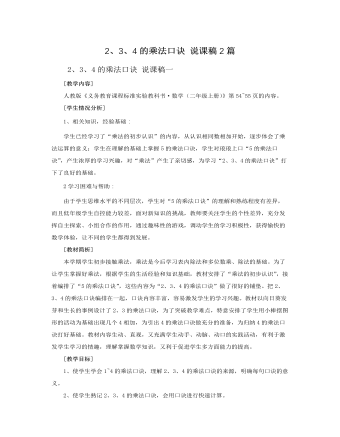
人教版新课标小学数学二年级上册2、3、4的乘法口诀 说课稿2篇
3、在学生已有了乘法口诀的数学模式后,引导学生运用已有经验,亲自参与其它乘法口诀的学习,充分发挥学生的主体作用,发展学生的思维。4、多采用提问让学生思考的方法,让学生在操作过程中想老师提出的问题,培养学生的抽象概括能力。如:在摆了两根小棒后问学生:现在摆了几根小棒?可以用几表示?摆了几个2根?用乘法算式应怎样表示等。5、运用磁性黑板摆实物,让学生能够通过观察实物直观感知,如:问2个2是多少?学生实在不能想的可以通过看图数数来完成,这样便可以照顾学习有困难的学生。学生已经对乘法的含义有了初步的理解,掌握口诀就比较容易;但是,要熟记乘法口诀并准确的运用还需花较大的精力和时间,因此,要引导学生学会由加法到乘法,再到口诀的归纳法,由易到难,循序渐进的方法。如:2个2,可以用加法22=4,再到写乘法算式2×2=4,再归纳出口诀“二二得四”;先引导学生说出1个2是多少?编出口诀,再引导说出2个2是多少,编出口诀等等。
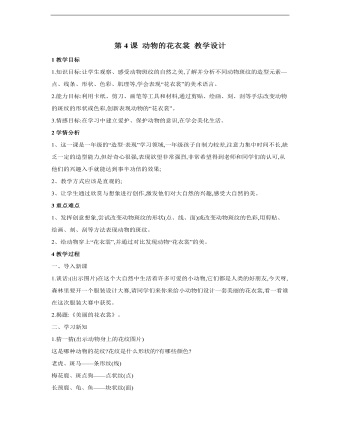
小学美术桂美版一年级上册《第4课动物的花衣裳》教学设计说课稿
2学情分析 1、这一课是一年级的“造型·表现”学习领域,一年级孩子自制力较差,注意力集中时间不长,缺乏一定的造型能力,但好奇心很强,表现欲望非常强烈,非常希望得到老师和同学们的认可,从他们的兴趣入手就能达到事半功倍的效果;2、教学方式应该是直观的;3、让学生通过欣赏与想象进行创作,激发他们对大自然的兴趣,感受大自然的美。
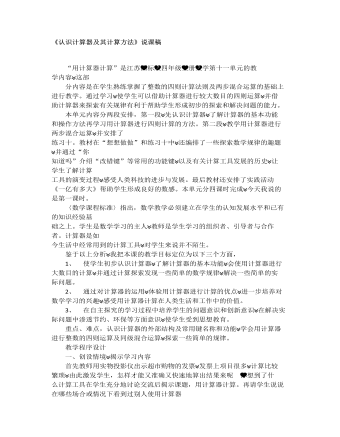
小学数学人教版四年级上册《认识计算器及其计算方法》说课稿
“用计算器计算”是江苏国标版四年级上册数学第十一单元的教学内容这部分内容是在学生熟练掌握了整数的四则计算法则及两步混合运算的基础上进行教学。通过学习使学生可以借助计算器进行较大数目的四则运算并借助计算器来探索有关规律有利于帮助学生形成初步的探索和解决问题的能力。 本单元内容分两段安排,第一段先认识计算器了解计算器的基本功能和操作方法再学习用计算器进行四则计算的方法。第二段教学用计算器进行两步混合运算并安排了练习十。教材在“想想做做”和练习十中还编排了一些探索数学规律的趣题并通过“你知道吗”介绍“改错键”等常用的功能键以及有关计算工具发展的历史让学生了解计算工具的演变过程感受人类科技的进步与发展。最后教材还安排了实践活动《一亿有多大》帮助学生形成良好的数感。本单元分四课时完成今天我说的是第一课时。
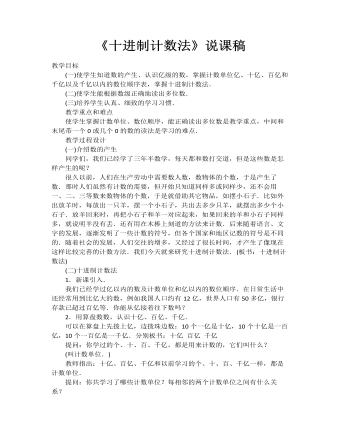
小学数学人教版四年级上册《十进制计数法》说课稿
(二)十进制计数法1.新课引入.我们已经学过亿以内的数及计数单位和亿以内的数位顺序.在日常生活中还经常用到比亿大的数,例如我国人口约有12亿,世界人口有50多亿,银行存款已超过百亿等.你能从亿接着往下数吗?2.用算盘数数,认识十亿、百亿、千亿.可以在算盘上先拨上亿,边拨珠边数:10个一亿是十亿,10个十亿是一百亿,10个一百亿是一千亿.分别板书:十亿 百亿 千亿提问:你学过的个、十、百、千亿,都是用来计数的,它们叫什么?(叫计数单位.)教师指出:十亿、百亿、千亿和以前学习的个、十、百、千亿一样,都是计数单位.
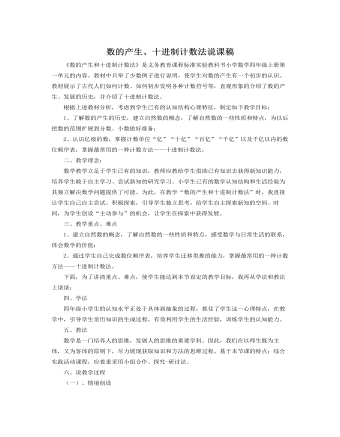
人教版新课标小学数学四年级上册数的产生、十进制计数法说课稿
2、十进制计数法(1)、师提问:“同学们,我们在前几节课已经学习了到万级为止的数,但是,还有比亿更大的数存在着,(出示数位顺序表):引导学生利用已有的知识进行类推,将已学过的亿以内数位顺序表扩展到“千亿”。教师在计数器上现场贴上亿级的数位。(教师向学生说明:还有比千亿更大的数,由于不常用,暂时不学,因此在数为顺序表后面用“…”,表示后面还有其他数位。)(2)、教师提问:“那么,我们已经学习了哪些计数单位呢?”(3)、小组讨论:“每相邻的两个计数单位之间的进率是多少?”请同学们自己得出结论:每相邻的两个计数单位之间的进率都是十。最后,教师给出“十进制计数法”的名称,在黑板上板书。(三)、课堂总结1、教师:“同学们,今天我们一起学习了?”教师请同学们接下去说完整:“自然数和十进制计数法。”
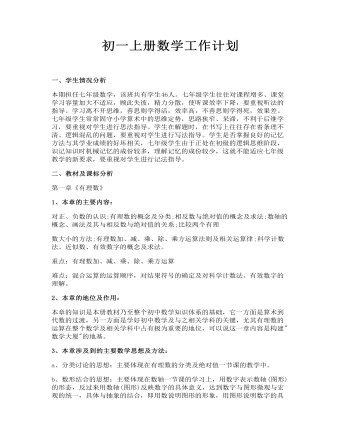
初一上册数学工作计划
第一章《有理数》1、本章的主要内容:对正、负数的认识;有理数的概念及分类;相反数与绝对值的概念及求法;数轴的概念、画法及其与相反数与绝对值的关系;比较两个有理数大小的方法;有理数加、减、乘、除、乘方运算法则及相关运算律;科学计数法、近似数、有效数字的概念及求法。重点:有理数加、减、乘、除、乘方运算难点:混合运算的运算顺序,对结果符号的确定及对科学计数法、有效数字的理解。
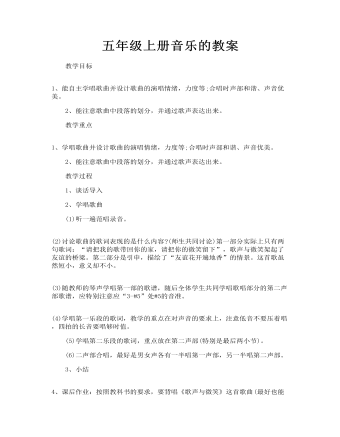
五年级上册音乐的教案
(1)听一遍范唱录音。 (2)讨论歌曲的歌词表现的是什么内容?(师生共同讨论)第一部分实际上只有两句歌词:“请把我的歌带回你的家,请把你的微笑留下”,歌声与微笑架起了友谊的桥梁。第二部分是引申,描绘了“友谊花开遍地香”的情景。这首歌虽然短小,意义却不小。
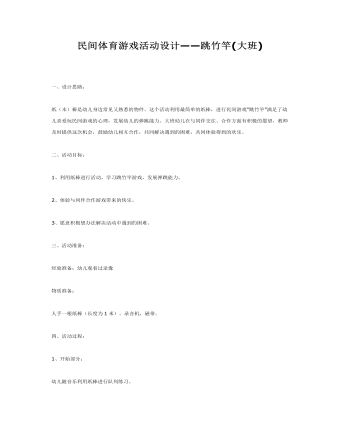
大班体育教案:民间体育游戏活动设计—跳竹竿
二、活动目标:1、利用纸棒进行活动,学习跳竹竿游戏,发展弹跳能力。2、体验与同伴合作游戏带来的快乐。3、愿意积极想办法解决活动中遇到的困难。三、活动准备:经验准备:幼儿观看过录像物质准备:人手一根纸棒(长度为1米)。录音机,磁带。四、活动过程:1、开始部分:幼儿随音乐利用纸棒进行队列练习。导语:今天天气真不错,我们骑着马出去玩玩吧!(幼儿随音乐的变化“骑马”变双圆----大圆----小圆---- “坐马车” )反思:活动开始部分设计了随音乐利用纸棒进行队列练习在这一环节中由两队“骑马”变双圆----变小圆----合作组合“坐马车”体现了动静交替的原则,让幼儿初步尝试了与同伴合作的快乐,同时也为下一个环节奠定了基础。2、基本部分:(1)利用纸棒进行“一棒多玩”导语:纸棒可以和我们玩坐马车的游戏,还可以和我们玩什么游戏呢?我们一起来试试,可以自己玩,也可以和小伙伴一起玩。(幼儿四散游戏)队形:两路纵队(见附图)(2)学习“跳竹竿”游戏A、讲解游戏玩法导语:刚才小朋友用纸棒玩了许多游戏,今天老师要和大家用纸棒玩一个新游戏——跳竹竿,这个游戏可以三个或四个小朋友一起玩,其中两个小朋友手拿竹竿面对面跪下,用竹竿同时分合敲击,另一个小朋友在中间看准竹竿的分合跳进或跳出。大家可以自己选择小伙伴一起试一试。队形:梯形队(见附图)(3)幼儿自由组合尝试玩“跳竹竿”游戏队形:四散(4)对幼儿在游戏过程中出现的情况及时进行指导(合作、交往方面)导语:你刚才和谁一起玩的?你们是怎么跳竹竿的?队形:梯形队(见附图)(5)鼓励幼儿创造性地玩“跳竹竿”游戏,师生共同参与。

新人教版高中英语必修3Unit 4 Space Exploration-Listening&Speaking&Talking教学设计一
Listening and Speaking introduces the topic of “talking about how to become an astronaut”. This period is aimed to inform students some details about the requirements of being an astronaut. Students can be motivated and inspired by the astronauts. Teachers ought to encourage students to learn from them and let them aim high and dream big.Listening and Talking introduces the theme of "talk about life in space". This part also informs students more details about life in space and can inspire students to be curious about this job. 1. Guide students to listen for numbers concerning dates, years and ages etc2. Cultivate students' ability to talk about how to become an astronaut and life in space ; 3. Instruct students to use functional sentences of the dialogue such as “ first of all, I am not sure, so what might be .. I guess.. I wonder…I am curious…)appropriately.1. Guide students to understand the content of listening texts in terms of the whole and key details; 2. Cultivate students' ability to guess the meaning of words in listening; discuss with their peers how to become a qualified astronaut and describe the life in space.Part 1: Listening and SpeakingStep 1: Lead inPredictionThe teacher can ask students to predict what the listening text is about by looking at the pictures.About how to become an astronaut./the requirements of an astronautStep 2: Then, play the radio which is about an interview a. And after finishing listening for the first time, the students need to solve the following tasks.

新人教版高中英语必修3Unit 4 Space Exploration-Discovering Useful Structure教学设计
The theme of the section is “Describe space facts and efforts to explore space”. Infinitives are one of non-finite verbs, as the subjects, objects, predicative, attributes and adverbials. This unit is about space exploration, which is a significant scientific activity, so every scientific activity has strong planning. Therefore, using the infinitives to show its purpose, explanations or restrictions is the best choice.1. Learn the structure, functions and features of infinitives.2. Learn to summarize some rules about infinitives to show purpose and modify.3. Learn to use infinitives in oral and writing English. 1. Learn the structure, functions and features of infinitives.2. Learn to summarize some rules about infinitives to show purpose and modify.3. Learn to use use infinitives in oral and writing English.Step 1 Lead in---Pair workLook at the following sentences and focus on the italicized infinitives. In pairs, discuss their functions. 1. I trained for a long time to fly airplanes as a fighter pilot..(作目的状语)2. As we all know, an astronaut needs to be healthy and calm in order to work in space..(作目的状语)3. First of all, you must be intelligent enough to get a related college degree..(作目的状语)4. Some scientist were determined to help humans realise their dream to explore space..(作定语)5. On 12 April 1961, Yuri Gagarin became the first person in the world to go into space..(作定语)Summary:1. 不定式的结构:to+do原形。2. 分析上面的句子,我们知道在描述太空探索时,动词不定式不仅可以用来表目的,还可以用来作定语,表修饰。
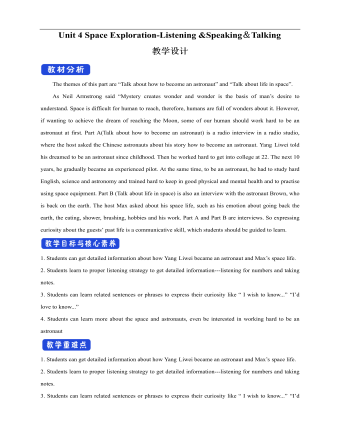
新人教版高中英语必修3Unit 4 Space Exploration-Listening&Speaking&Talking教学设计二
The themes of this part are “Talk about how to become an astronaut” and “Talk about life in space”. As Neil Armstrong said “Mystery creates wonder and wonder is the basis of man’s desire to understand. Space is difficult for human to reach, therefore, humans are full of wonders about it. However, if wanting to achieve the dream of reaching the Moon, some of our human should work hard to be an astronaut at first. Part A(Talk about how to become an astronaut) is a radio interview in a radio studio, where the host asked the Chinese astronauts about his story how to become an astronaut. Yang Liwei told his dreamed to be an astronaut since childhood. Then he worked hard to get into college at 22. The next 10 years, he gradually became an experienced pilot. At the same time, to be an astronaut, he had to study hard English, science and astronomy and trained hard to keep in good physical and mental health and to practise using space equipment. Part B (Talk about life in space) is also an interview with the astronaut Brown, who is back on the earth. The host Max asked about his space life, such as his emotion about going back the earth, the eating, shower, brushing, hobbies and his work. Part A and Part B are interviews. So expressing curiosity about the guests’ past life is a communicative skill, which students should be guided to learn.1. Students can get detailed information about how Yang Liwei became an astronaut and Max’s space life.2. Students learn to proper listening strategy to get detailed information---listening for numbers and taking notes.3. Students can learn related sentences or phrases to express their curiosity like “ I wish to know...” “I’d love to know...”4. Students can learn more about the space and astronauts, even be interested in working hard to be an astronaut
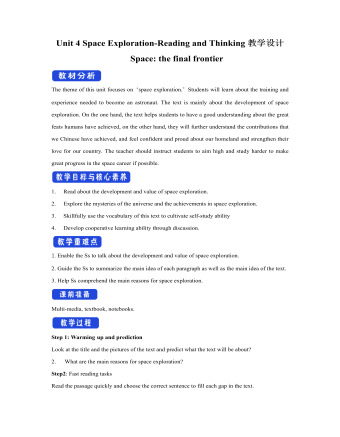
新人教版高中英语必修3Unit 4 Space Exploration-Reading and Thinking教学设计二
The theme of this unit focuses on “space exploration.” Students will learn about the training and experience needed to become an astronaut. The text is mainly about the development of space exploration. On the one hand, the text helps students to have a good understanding about the great feats humans have achieved, on the other hand, they will further understand the contributions that we Chinese have achieved, and feel confident and proud about our homeland and strengthen their love for our country. The teacher should instruct students to aim high and study harder to make great progress in the space career if possible.1. Read about the development and value of space exploration.2. Explore the mysteries of the universe and the achievements in space exploration.3. Skillfully use the vocabulary of this text to cultivate self-study ability 4. Develop cooperative learning ability through discussion.1. Enable the Ss to talk about the development and value of space exploration.2. Guide the Ss to summarize the main idea of each paragraph as well as the main idea of the text.3. Help Ss comprehend the main reasons for space exploration. Multi-media, textbook, notebooks.Step 1: Warming up and predictionLook at the title and the pictures of the text and predict what the text will be about?2. What are the main reasons for space exploration?
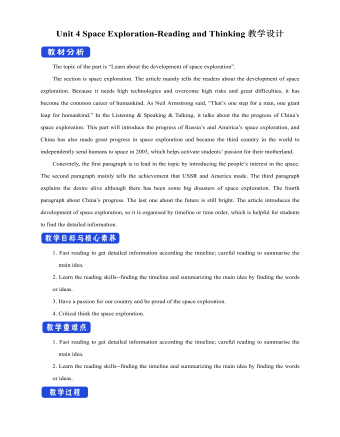
新人教版高中英语必修3Unit 4 Space Exploration-Reading and Thinking教学设计一
Q4: What is the function of the International exploration ?Having astronauts from different countries on boardQ5: What can you learn from Para 4 ?China has made great achievements in exploring spaceQ6: What is the attitude to the space exploration ?SupportiveStep 6 Post reading---RetellPeople have always wanted to learn more about space. Before the mid-20th century, most people felt (1)_________ (travel) into space was an impossible dream. However, (2)____ the help of scientists, peoplesucceeded in realizing their dream (3) _________ (explore) space. On 4 October 1957, the Sputnik 1 satellite (4) ____________(launch) by the USSR. (5) ________________ scientists try to make sure nothing goes wrong, accidents can still happen. These disasters made everyone(6)___________(disappoint), but people still believe in the importance of (7) ________(carry) on space exploration. In 2003, China became the third country to (8)_____________ (independent) send humans into space. Then Shenzhou 6 and 7 completed (9)____ second manned orbit and the first Chinese spacewalk. In spite of the difficulties, scientists hope future (10)__________ (discovery) will not only enable us to understand the universe but also help us survive well into the future.Answers: 1. travelling 2. with 3. to explore 4. was launched 5. Although6. disappointed 7. carrying 8. independently 9. a 10. discoveriesStep 6 Post reading---Critical thinkingQ1: What do you think of the space exploration ? I think it is beneficial to us. Through further study of space, people will make full use of it in the future, such as the space experiments by Wang Yaping in Tian Gong 1.Q2: If you are determined to be an astronaut, what should you prepare at present ?First of all, I should study hard to get a related college degree. Besides, I must keep mental and physical healthy.Step 7. HomeworkTry to summarize the structure of the article by a mind map.
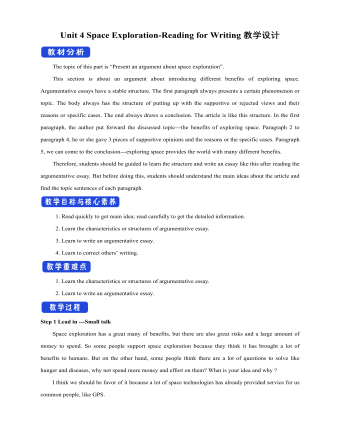
新人教版高中英语必修3Unit 4 Space Exploration-Reading for Writing教学设计二
⑦在我看来, 探索太空是值得的。As far as I am concerned, it is worthwhile to explore the space.Step 10 Writing---draftRecently, students in our class have had heated a discussion on whether space is worth exploring. Students hold different ideas about it.30% of us think space exploration is not worthwhile. They think space is too far away from us and our daily life and is a waste of money. And the money spent on space exploration can be used to solve the earth’s problems such as starvation and pollution.On the other hand,70% think space is worth exploring because we have benefited a lot from it,such as using satellites for communication and weather forecast. What’s more,with further space research,we may solve the population problem by moving to other planets one day. Also,space research will enable us to find new sources to solve the problem of energy shortages on the earth.As far as I am concerned, it is worthwhile to explore the space. Not only can it promote the development of society but also enrich our life. Step 11 Pair workExchange drafts with a partner. Use this checklist to help your partner revise his/her draft.1.Does the writer explain why he/she changed/wanted to change?2.Does the writer tell how the changes have improved or will improve his/her life?3.Is the text well-organised?4.Does the writer use words and expressions to show similarities and differences?5.Are there any grammar or spelling errors?6.Does the writer use correct punctuation?

新人教版高中英语必修3Unit 4 Space Exploration-Reading For Writing教学设计一
另一方面,其余的人反对这个计划,因为它可能会导致一些不好的影响。7.I hold the belief that space exploration not only enable us to understand how the universe began but also help us survived well into the future.我坚信探索太空不仅能够使我们了解宇宙的起源而且能够帮助我们更好地走进未来。8.I think we should spend more time and money exploring space so as to provide new and better solutions to people's shortterm and longterm problems.为了给人类的短期和长期问题提供更新和更好的解决方法,我认为我们应该花更多的时间和金钱来探索太空。9.From my point of view,it is wrong of young people to depend on their telephones too much,which may do harm to both their physical and mental health.在我看来,年轻人过度依赖手机是不对的,因为它们可能会对他们的身心健康都有害。最近你班同学就“人类是否应该进行宇宙探索”这个问题进行了激烈的讨论。有人认为,探索宇宙不仅让人类更好地了解宇宙的发展,还可以用来指导农业生产,以及把一些探索太空的高新技术用于现实生活;也有一些人认为探索太空花掉了大量的人力物力;影响了人们的生活水平。请你根据以下情况写一篇报告并发表自己的观点。注意:1.写作内容应包括以上全部要点,可适当发挥,使上下文连贯;
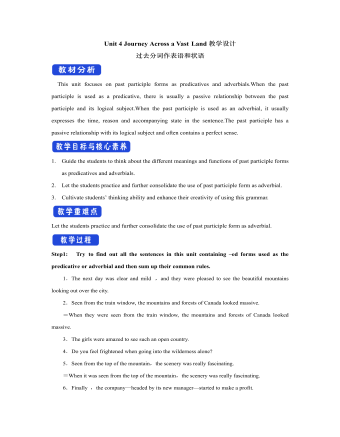
新人教版高中英语选修2Unit 4 Journey Across a Vast Land教学设计
当孩子们由父母陪同时,他们才被允许进入这个运动场。3.过去分词(短语)作状语时的几种特殊情况(1)过去分词(短语)在句中作时间、条件、原因、让步状语时,相当于对应的时间、条件、原因及让步状语从句。Seen from the top of the mountain (=When it is seen from the top of the mountain), the whole town looks more beautiful.从山顶上看,整个城市看起来更美了。Given ten more minutes (=If we are given ten more minutes), we will finish the work perfectly.如果多给十分钟,我们会完美地完成这项工作。Greatly touched by his words (=Because she was greatly touched by his words), she was full of tears.由于被他的话深深地感动,她满眼泪花。Warned of the storm (=Though they were warned of the storm), the farmers were still working on the farm.尽管被警告了风暴的到来,但农民们仍在农场干活。(2)过去分词(短语)在句中作伴随、方式等状语时,可改为句子的并列谓语或改为并列分句。The teacher came into the room, followed by two students (=and was followed by two students).后面跟着两个学生,老师走进了房间。He spent the whole afternoon, accompanied by his mom(=and was accompanied by his mom).他由母亲陪着度过了一整个下午。
